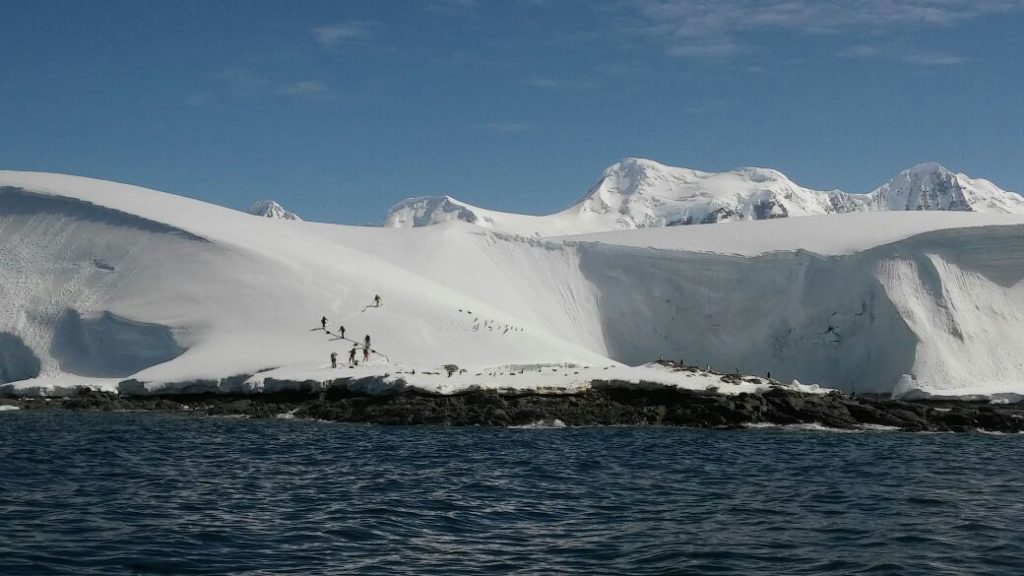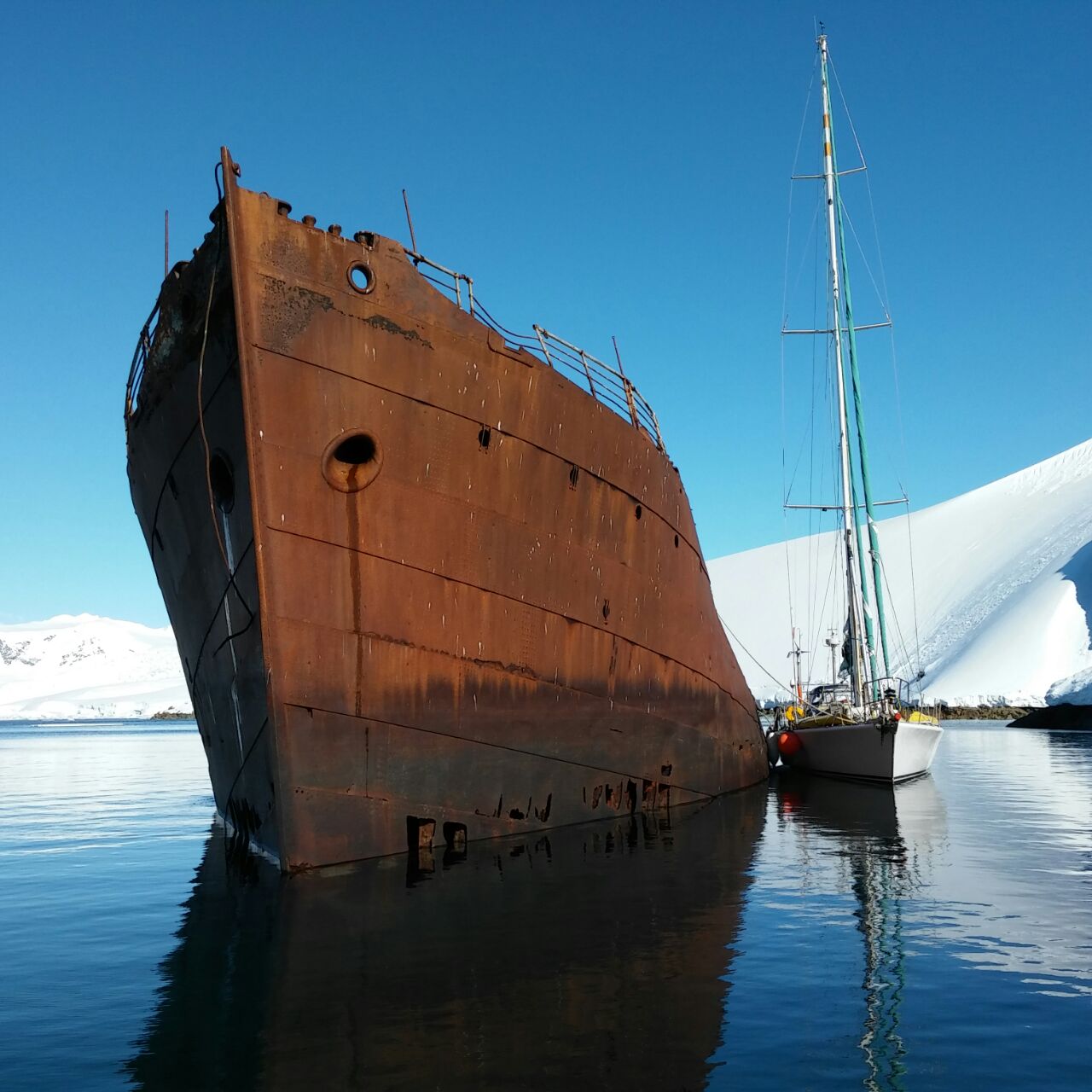The baby humpback whale dived to seek out its dinner or just for the
hell of it. A minute or two later she surfaced and exhaled. Just fifty
meters offshore she was obviously finding her bearings, possibly her
first of many, visits to Antarctica and its krill-rich waters..
Earlier, while we were skiing, Darrel, Maggie and Matt saw the rest of
the her family and some Minke around our anchored boat.
Rewind three days…
We arrived in Port Lockroy on the evening of the 4th December. As we
rounded Damoy Point and headed into towards Goudier Island where the
base is located, Darrel instructed us that we were to moor in the sea
ice. We gently drove bow first straight into the soft ice at the head
of the bay. Once fast, Mark and Bruce jumped off the bow onto the ice
and dragged the main anchor 50m forward, tipped it point first into the
ice and we then wound in on the windlass. Two further lines to
starboard and port from our rear drums ensured we were firmly secure in
a rising wind and gathering snowstorm.
Monday the 5th dawned (debateable as it is never dark now) and we were
to be tourists for the morning. Port Lockroy is the former BAS base
that is now run by the British Antarctic Heritage Trust as a living
museum. It is a honeypot for the cruise ships, with as many as two
ships arriving each day and disgorging their passengers, 30 at a time,
to visit the time capsule of a base. A great visit, but spare a moment
for the staff of four who rely on the cruise ships for their water,
showers and laundry!
In the afternoon we skinned from the boat over the sea ice up onto the
glacier and round onto Jabet Peak on Wiencke island. We climbed in
sunshine and soaked up the awesome majesty of the Fief Mountains and the
Wall Range mountains which form the stunning, intimidating backdrop to
Lockroy.
After a great ski down from Jabet we arrived at another BAHT-maintained
hut named Damoy Hut. This beautifully restored hut was a former
glacier-air station for BAS, allowing ships to drop men and supplies at
Lockroy and for them to be flown on further south to the main base at
Rothera. This was critical as the ice often prohibited ship-borne
access until later in the Antarctic summer. The hut still had
provisions, stoves and a dorm. A previous visit by Spirit in 2009 with a
group of boys from Geelong Grammar school in Melbourne spent a week
helping refurbish the hut. A gentle skin back to the boat was ended by
a fantastic 45 degree drop onto a minute beach where Matt picked us up.
A great day ended with dinner and an official audit by me, revealing 34
bottles of wine. Probably the best bit of news Andy had heard all week.
The 6th dawned with cloud and snow, the wind was now in the south and
Darrel advised that we get out quick as Lockroy can get set with ice
very easily at this time of year. We headed down Peltier Channel under
the Fief Mountains now cloaked in cloud. The seven Fief sisters were
climbed in one expedition by a crack french climbing group a few years
back. As we approached Cape Errera our passage was blocked by thick
ice. My drone was deployed to fly over the ice to see if there were any
leads that would allow us to access the Gerlache so we could sail up to
Paradise Harbour. After a crash, of the drone, resulting in a lost
battery, we had a successful flight that unfortunately showed that the
ice was fast and impassable. We about turned, past Lockroy and round
into the Neumayer. As we passed Marie Australis, another skiing yacht,
we advised them of how much ice was headed their way. Unfortunately they
did not heed our warning and two days later they remain iced in!
The trip up the Neumayer was hard, the brash ice was now mixed with
first-year ice and glacier ice. This required a constant watch to spy
out a clear(ish) passage into the Gerlache. It was remarkable how much
the ice had increased in the space of just two days.

We headed towards Paradise Harbour, our next destination, on the
Penninsular. As we entered the Bryde Channel we passed a small Chilean
naval cutter and soon found ourselves set in thick ice. About half a
mile ahead Pelagic Australis was barging her way through thickening ice.
We forced our way forward in snow and overcast conditions. Our route
finding towards the anchorage at Skontorn Cover adjacent to the ‘Burnt’
Brown Argentinian base a mixture of following the red antifoul marks
left by Pelagic Australis as she rammed her way through the ice and part
sighting the least-iced route to our venue.
The going was hard, slightly nerve-wracking and desperately slow.
Darrel would seek out patches of first year ice, nose Spirit into its
midships and then use this pad of soft ice as a plough to clear a way
through the much harder and destructive glacier ice. Some of these soft
bergs were as large as fifty by fifty meters and would slowly
disintegrate as we pushed our protective buffer, at half a knot, into
successive evil-looking twisted chunks of glacier ice.
Progress had slowed to snail’s pace and we were growing seriously
concerned that we might not make it. The only thing that kept us going
was that Darrel was able to speak with Dave, the skipper of Pelagic
Australis, now about 500m ahead. Dave was able to report that the ice
was thinner close to Skontorn.
The last mile was made easier by a particularly resilient first-year ice
berg that became, deliberately, impaled on our bow. It spurned all
attacks from its more malicious glacier and brash ice cousins. We
finally escaped the ice and anchored with an additional stern line in
this spectacular cove. Just to the east Avalanche Glacier cascaded into
the bay with awesome ferocity. Pelagic Australis and Spirit lay licking
their collective wounds after a spirited battle of nearly three hours
through trully unbelievable ice. Paradise was more ParadICE.
The 7th arrived with blue skies and no wind. As we nosed out of the
Cove it immediately became apparent that the ice was far lighter than
the previous day. A quick drone reconnoiter showed that the Bryde
channel was less iced than the Ferguson. We therefore headed north
towards the Gabriel Gonzalez Videla base and Lemaire Island at the
northern end of Paradise Harbour.
Ahead and to starboard were two cruise ships we had seen the previous
day at Lockroy, Seabourne Quest and one of the National Geographic
boats. They had obviously followed the path forged by us through the ice!
As we passed Seabourne, their zodiacs buzzed around filled with punters
on trips around the harbour. We motored past its starboard side and
shouted greetings. Note to self, do not go to Antarctica on a cruise ship!
We were dropped off on Lemaire Island at the northern end of Aguirre
Passage. The skin up Rojas Peak surrounded by astonishing scenary, was
only slightly compromised by the cruise ships below us. At 670m the
peak was a stunner. We were able to skin to within fifty meter of the
snow dome summit. We then cramponed up through thick, soft snow and
celebrated a breathtaking ascent. We scrambled back to the skis,
switched them to downhill mode and enjoyed the most spectacular 500m ski
on the planet. Mount Parry on Brabant Island lay in the distance, Mount
Francais on Anvers Island to the west and a vast tabular iceberg about
the size of a small English village ambled its way north in the Gerlache.
Exhilarated we skinned back up to a col from where we enjoyed a second
beautiful ski through a small glacier field to the pick up point where
Matt brought the zodiac over to collect us.
The day was not over. Despite it being past 18.30, we were determined
to take advantage of the fantastic weather and see if we could capture
some drone footage of us skiing. Off we headed to the Chilean base,
skins back on and a 300m skin up above Waterboat Point. I peeled off at
230m and set up the drone in the beautiful evening light. The rest of
the team carried on to a shoulder. Communicating by radio we liaised
when the skiers were ready and I launched the drone and promptly crashed
it as the wind drove it head first into the, fortunately, soft snow. A
second attempt was successful, though the wind made for challenging
flying. Despite this we managed to get some great footage of the skiers
which should be cut beautifully into our expedition film!
At 21.00 we arrived back at the beach and enjoyed a dinner, but not
before the aforementioned Humpback whale made its appearance. All
around hundreds of Gentoo penguins porpoised their way home for the
evening returning with krill for their nesting partners.
As the sun set on a truly incredible day on the mountain and with the
team, we toasted Antarctica, wilderness skiing and a great team.
Beat that….
MarkB 7.12.16


Wow! Amazing Markie – can’t wait for the slide-show when you get home. Enjoy your last two days chaps xxx